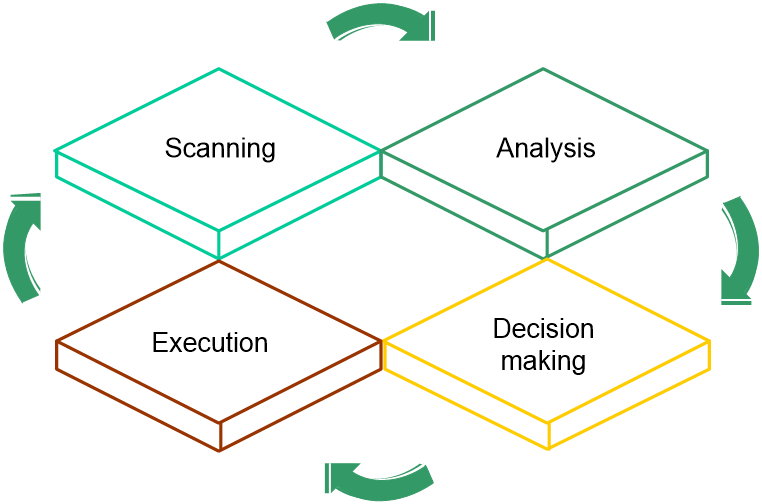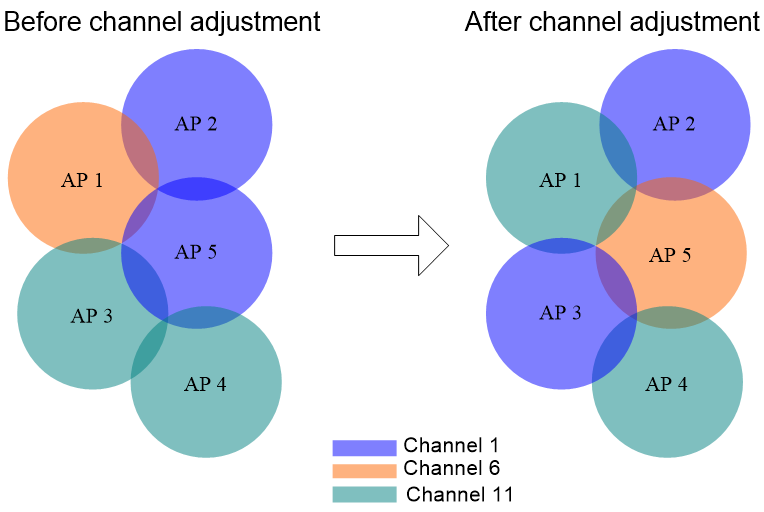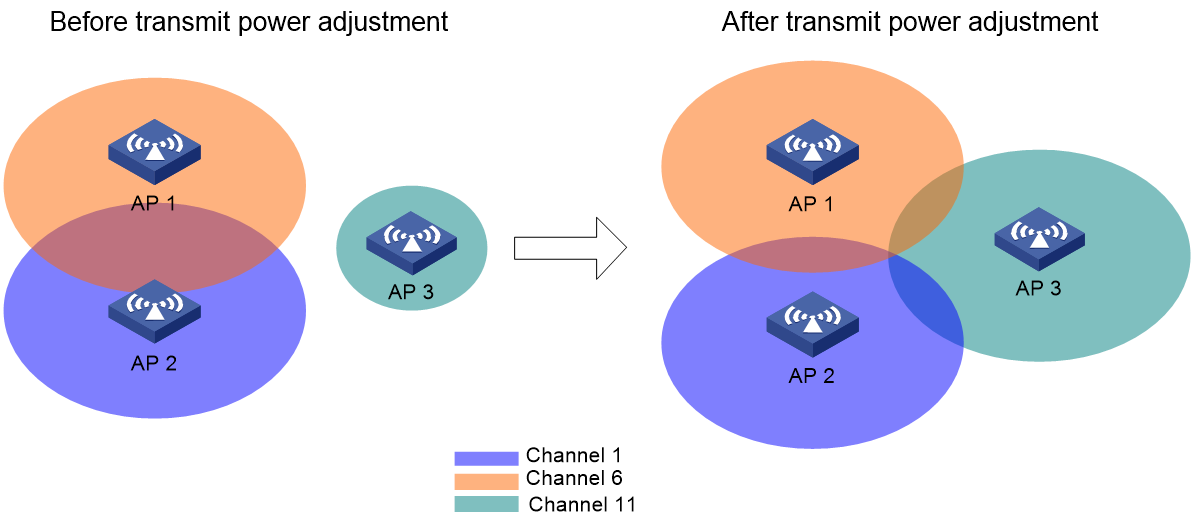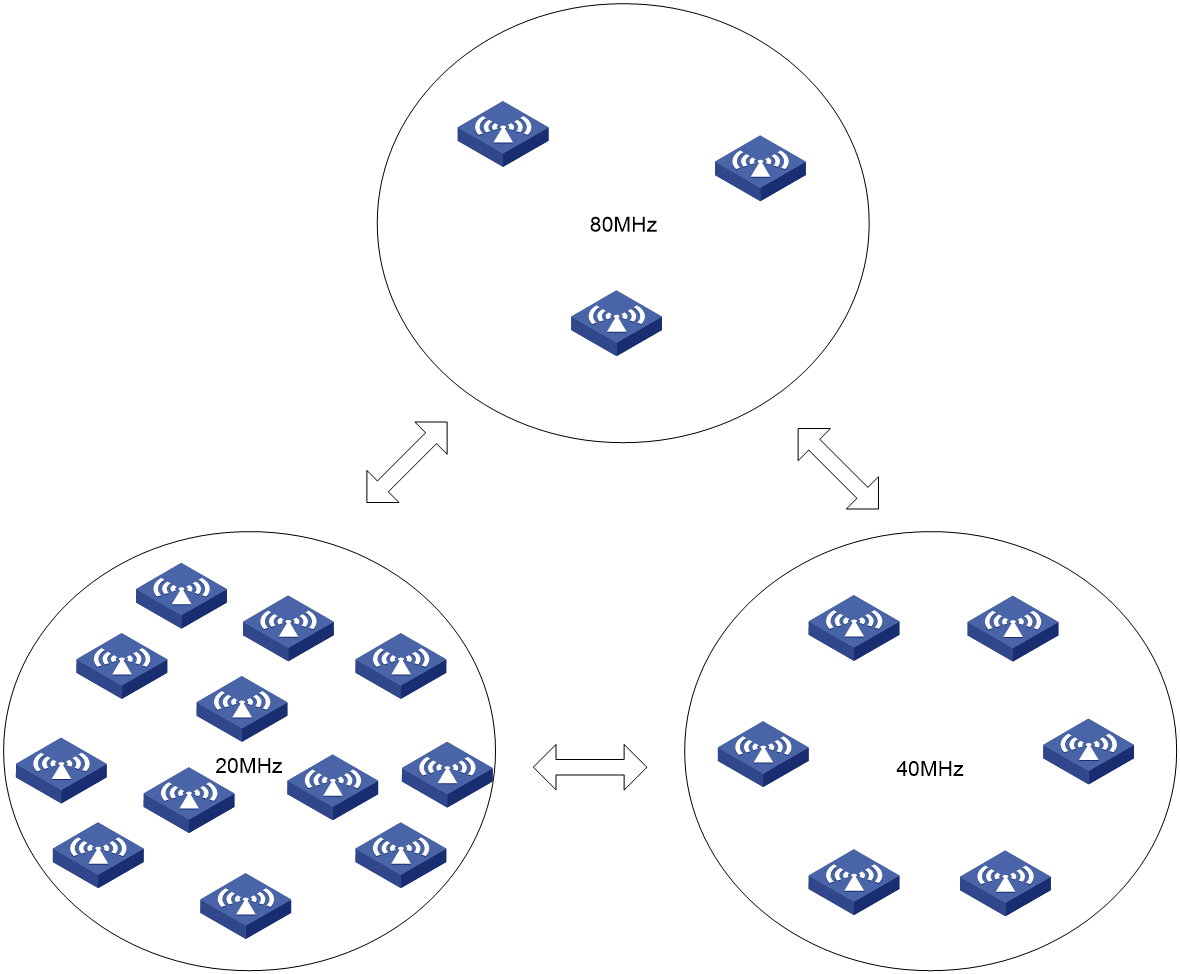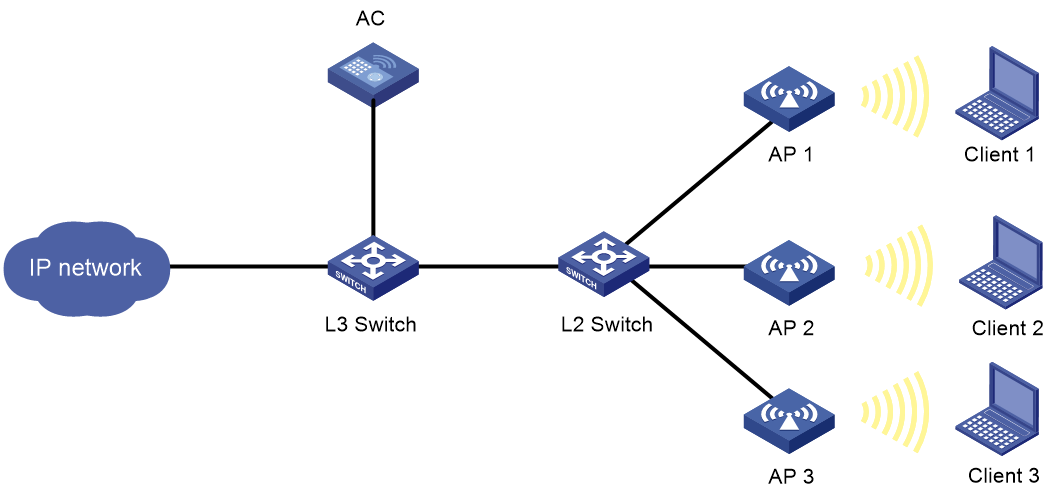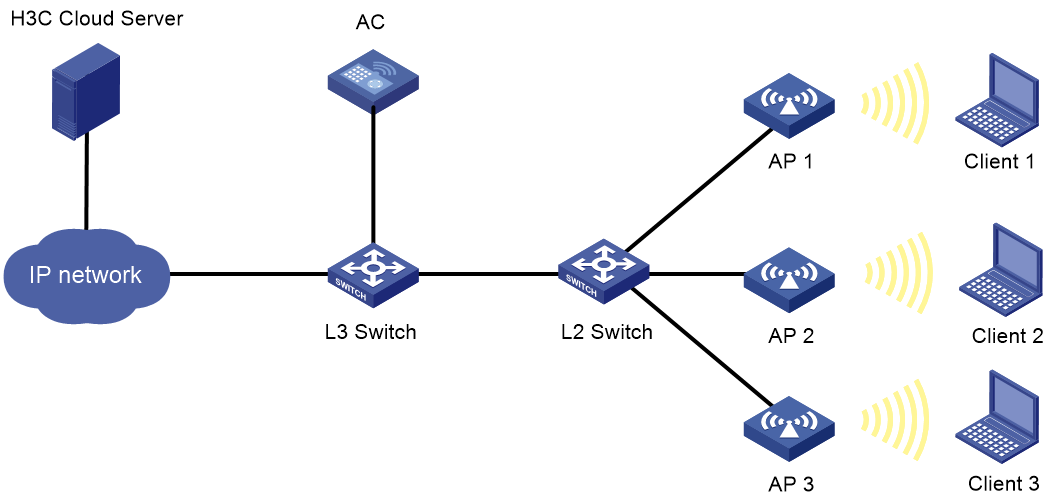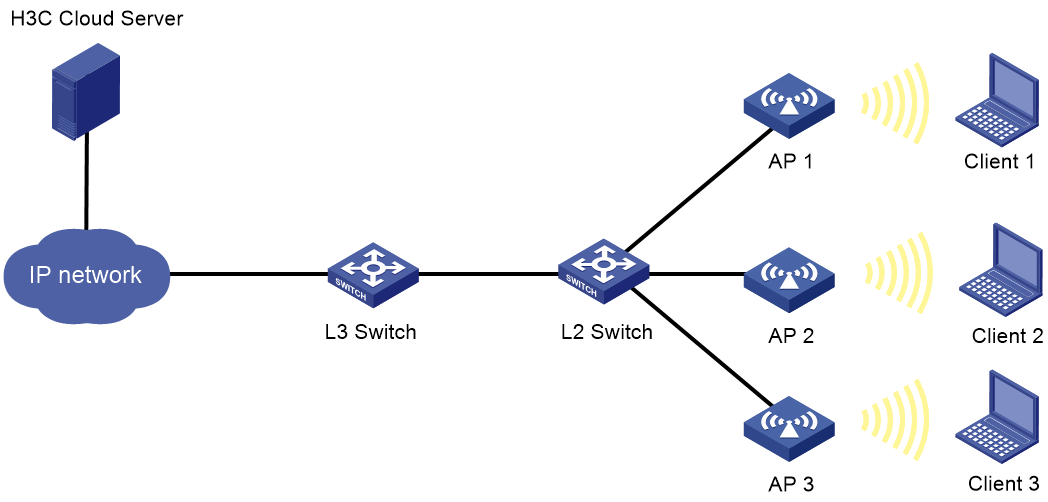| Title | Size | Downloads |
|---|---|---|
| Intelligent Radio Resource Adjustment Technology White Paper-6W100-book.pdf | 604.36 KB |
- Table of Contents
- Related Documents
-
Intelligent Radio Resource Adjustment Technology White Paper
Copyright © 2022 New H3C Technologies Co., Ltd. All rights reserved.
No part of this manual may be reproduced or transmitted in any form or by any means without prior written consent of New H3C Technologies Co., Ltd.
Except for the trademarks of New H3C Technologies Co., Ltd., any trademarks that may be mentioned in this document are the property of their respective owners.
The information in this document is subject to change without notice.
Intelligent RRM implementation
Auto transmit power adjustment
Cloud-based RRM for AC+fit AP networks
Cloud-based RRM for cloud-managed AP networks
Overview
Technical background
With the popularization of wireless networks and the rapid growth of wireless users, wireless network O&M is getting increasingly difficult. At the same time, increasing user demands for network applications also makes it urgent for WLANs to provide high-quality network experience in real time. Traditional O&M relies on manual adjustment of radio parameters (channel, power, and bandwidth), which mainly have the following problems:
· Professional network administrators are required.
· Manual adjustment is complicated and time-consuming in a large-sized network.
· Manual adjustment cannot respond in time to network changes, including network scale-up, scale-down, AP failure, and ambient changes.
· Manual adjustment takes a long time and has a high cost, which makes it hard to form a high-efficiency closed-loop.
· Issues cannot be detected immediately, which affects user experience.
To resolve the issue, intelligent Radio Resource Management (RRM) is introduced to adjust channel, power, and bandwidth parameters of radios automatically in case of network changes.
Intelligent RRM features are available in the following forms:
· AC-based RRM—Performs calibration based on local data.
· Cloud-based RRM—Requires device connection to the public cloud or private cloud.
When both AC-based RRM and cloud-based RRM are configured, cloud-based RRM is responsible for unified resource scheduling and adjustment.
Benefits
RRM monitors wireless environment, collects and analyzes wireless environment data, and uses intelligent calibration algorithms to generate radio optimization policies. H3C intelligent RRM provides the following benefits:
· Sense network changes in time and make corresponding adjustments to reduce the impact of network changes on user experience.
· Reduce the required O&M manpower, time, and costs.
· Minimize the duration of the impact of wireless environment changes on user experience.
· Continue to improve the network quality and user experience through continuous optimization.
Intelligent RRM is applicable to the following scenarios:
· Small- to medium-sized networks lacking professional O&M personnel.
· Large-sized networks with a large number of APs, such as offices, universities and colleges, and large-scale shopping malls.
|
· |
NOTE: Intelligent RRM adjusts radio channel, transmit power, and bandwidth parameters automatically. For scenarios that require fixed channel, transmit power, or bandwidth, such as healthcare roaming and AGV networks, do not configure intelligent RRM as a best practice. |
Intelligent RRM implementation
Concepts
· Channel adjustment
In a WLAN, a radio can only work on a limited number of channels, where there may be a lot of interference from both wireless devices and non-wireless devices, such as radar transmitters and microwave ovens. With channel adjustment, the system automatically assigns an optimal channel for each radio in real time to avoid co-channel interference and interference from other radio sources.
· Power adjustment
Traditional power control sets the transmit power of a radio to the maximum value to maximize the signal coverage, which causes unnecessary interference to other wireless devices and sticky clients. This reduces the overall capacity and user experience of the system, and cannot meet the high throughput requirement.
Power adjustment of intelligent RRM can ensure the signal coverage and reduce unnecessary interference at the same time by allocating a reasonable transmit power for each radio.
· Bandwidth adjustment
Configuring all radios to use the maximum bandwidth increases the negotiated rate between AP and client, but causes severs co-channel interference due to limited wireless channels.
Bandwidth adjustment of intelligent RRM can balance negotiated rate and interference and thereby improve the capacity of the entire network.
AC-based RRM
Mechanism
AC-based RRM uses the computing capacity to analyze the local data. It operates as follows:
1. Scanning
APs scan channels regularly after coming online and report collected information to the AC at specific intervals. To avoid affecting wireless services, APs scan channels only when no service traffic is being transmitted.
2. Analyzing
The AC analyzes the received information, including channel quality, channel interference conditions, and adjacent AP distribution, and builds a model of the surrounding network with real-time awareness of network changes for decision making.
3. Decision making
Based on the analysis result, the AC uses intelligent algorithms to adjust and optimize radio resources, and automatically evaluates the impact of the adjustment on the network to ensure that the system is reliably adjusted to accommodate changes in the WLAN.
4. Execution
The AC sends the adjustment policy to the target AP, and the AP adjusts the channel, bandwidth, and transmit power as instructed in the policy. Users can view the history of AP radio adjustment on the AC.
The AC continuously monitors the network environment and records any wireless environment changes for the next round of adjustment.
Figure 1 AC-based RRM working mechanism
Auto channel adjustment
Factors that can trigger auto channel adjustment include the following:
· Error code rate—Physical layer error code rate and CRC error rate. CRC error rate shows the proportion of packets with CRC errors among all 802.11 packets.
· Interference—802.11 interference and non-802.11 interference.
· Channel usage—Proportion of channel resources used for packet transmitting and receiving.
· Retransmission—Packets retransmitted because an AP fails to receive an ACK.
· Radar—Radar signals detected in the current working channel.
If one or multiple such issues exist, the AC selects an optimal channel as the backup channel. If the working channel quality drops below the threshold, the AP uses the backup channel as the working channel. For example, as shown in Figure 2, before channel adjustment, AP 2 and its neighbor AP 5 operate on the same channel and AP 3 and its neighbor AP 4 operate on the same channel. After adjustment, adjacent APs operate on different channels, which minimizes co-channel interference.
Figure 2 Automatic channel adjustment
Auto transmit power adjustment
The AC determines whether transmit power adjustment is required for an AP based on the following factors:
· Signal strength of neighbor APs detected by the AP—Used to identify whether the current transmit power is reasonable.
· Signal strength of the AP detected by clients—Used to identify if coverage holes exist. The system must also take the roaming logics of clients into consideration to exclude sticky clients to prevent improper transmit power adjustment from exacerbating the sticky client issue.
The AC performs automatic transmit power adjustment as follows:
1. Examine if coverage holes exist. If coverage holes exist, the system increases the transmit power.
2. Obtain information about the transmit power of a radio from the neighbor reports uploaded by other radios, and compare the current radio's transmit power with the transmit power adjustment threshold.
¡ If the radio's transmit power is higher than the threshold and the gap reaches a specific value, the system decreases the transmit power.
¡ If the radio's transmit power is lower than the threshold and the gap reaches a specific value, the system increases the transmit power.
As shown in Figure 3, each AP has only one radio enabled. Before the adjustment, a coverage hole exists and the transmit power of AP 1 and the transmit power of AP 2 are too high. After the adjustment, the transmit power of AP 3 is increased to remove the coverage hole and the transmit power of AP 1 and the transmit power of AP 2 are decreased to reduce co-channel interference.
Figure 3 Transmit power control
Auto bandwidth adjustment
Auto bandwidth adjust uses the channel binding technology and takes AP density, AP model, and client quantity to assign a reasonable bandwidth for each radio. It follows the following principles:
· For low AP density, decrease radio bandwidth to reduce interference.
· For high AP density, increase radio bandwidth to increase the data transmission speed.
· Reduce overlapping channels for adjacent APs as much as possible to minimize co-channel interference.
· Ensure that APs and clients can negotiate appropriate rates, ensuring the access rate of clients and increasing the capacity of the entire network.
The AC performs channel quality evaluation at the end of each auto bandwidth adjustment period and decides whether to adjust the bandwidth based on the evaluation result.
As shown in Figure 4, when the AC detects that too many neighbor APs and clients exist for an AP, it decreases the radio bandwidth to reduce interference. When the AC detects that only a few neighbor APs and clients exist for an AP, it increases the radio bandwidth to increase the transmission speed and network capacity.
Figure 4 Automatic bandwidth adjustment
Cloud-based RRM
Mechanism
Cloud-based RRM is available in the Smart O&M section on the Cloudnet platform at https://oasiscloud.h3c.com. It is applicable for startup deployment and manual optimization, allowing users to optimize the network through a click.
One-key optimization operates as follows:
1. Examine device operation status and cloud connections.
2. Trigger devices to scan the network and obtain the AP configuration and scanning data.
3. Calculate radios to be adjusted based on the collected data.
4. Use the optimization algorithm to generate the radio adjustment policies.
5. Deploy the policies to devices for radio adjustment.
6. Save the adjustment record.
UI design
Optimization target customization
One-key optimization optimizes the network based on spaces.
· Global space—Optimize all APs in the site. The space as created automatically as the site was created and cannot be deleted.
· Customized space—Optimize APs by room or AP group, or optimize the selected APs. You can select a scenario type, and select an AP range.
Figure 5 Customizing optimization options
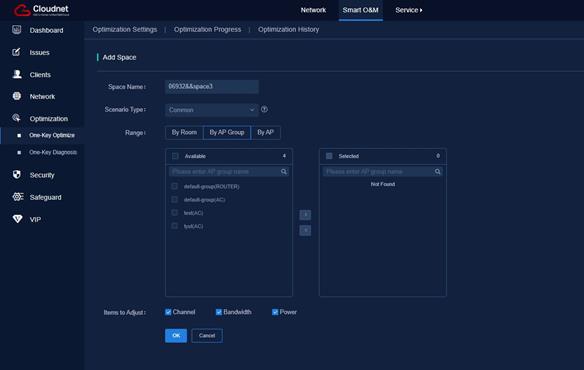
Process visibility
One-key optimization includes four steps: checking, scanning, optimization, and completion. You can view the process from the Web interface.
Figure 6 Process visibility

Optimization result displaying
If the optimization succeeds, the system displays information about the process, including AP quantity, start time, time consumption, and configuration comparison. If the optimization fails, the system displays the failure reason.
You can view the optimization history in the past week, including the neighbor AP channel, AP channel distribution, adjusted transmit power statistics, and adjusted APs.
· Neighbor APs and their channel usage—Displays channel relations between adjacent APs. A gray line indicates mutual neighbor relation, and a red line indicates that the radios use the same channel. You can view channel conflict conditions between adjacent APs in this graph.
Figure 7 Neighbor APs and channel usage
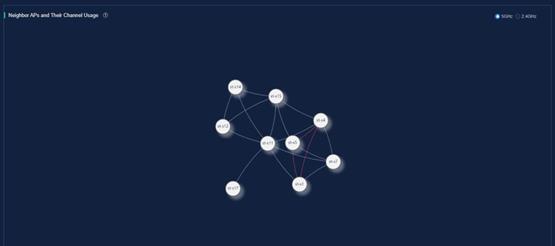
· AP distribution by channel—Displays the number of APs on each channel and the channel usage before and after the optimization.
Figure 8 AP distribution by channel
· Power adjustment statistics—Displays the power adjustment details.
Figure 9 Power adjustment statistics
· Optimized APs—Displays detailed optimization information for each AP.
Figure 10 Optimized APs

Typical applications
AC-based RRM
As shown in Figure 11, AC-based RRM can be used only in AC+fit AP networks for the AC to optimize all the managed APs.
Cloud-based RRM
Cloud-based RRM for AC+fit AP networks
Cloud-based RRM can be used in an AC+fit AP network. As shown in Figure 12, the AC established a cloud connection to the cloud platform and uses CAPWAP tunnels to communicate with APs.
Cloud-based RRM for AC+fit AP networks operates as follows:
1. APs report radio information to the AC, and the AC reports the information to the cloud platform.
2. The cloud platform analyzes the information and deploys radio parameters to be adjusted to the AC.
Figure 12 Cloud-based RRM for AC+fit AP networks
Cloud-based RRM for cloud-managed AP networks
As shown in Figure 13, Cloud-based RRM can be used in a cloud-managed AP network. This feature is not available on APs that does not support cloud management.
Figure 13 Cloud-based RRM for cloud-managed AP networks

